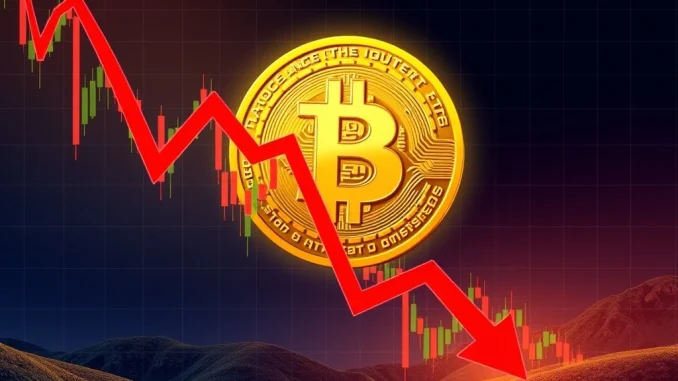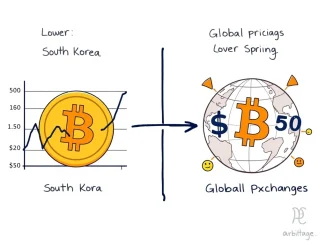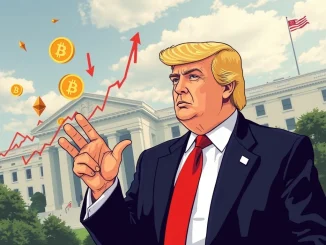
The world of cryptocurrency is always buzzing with activity, and recent data has given investors something new to ponder. After a remarkable 13-day streak of net inflows, U.S. Bitcoin ETFs experienced a notable reversal, recording a substantial $131.35 million in net outflows on July 21. This sudden shift has prompted many to ask: what does this mean for the market, and are these outflows a sign of things to come?
Bitcoin ETFs See Significant Reversal: What Happened?
The latest figures, shared by crypto data tracker Trader T on X, indicate a significant change in investor sentiment, at least for a single day. The $131.35 million net outflow on July 21 marks the end of a positive run for U.S. Bitcoin ETFs, which had previously enjoyed consistent inflows, signaling growing interest and adoption from traditional finance. This one-day reversal, while not necessarily indicative of a long-term trend, certainly caught the attention of market participants.
The initial approval of spot Bitcoin ETFs earlier this year was hailed as a landmark moment, opening the doors for a broader range of investors to gain exposure to Bitcoin without directly holding the digital asset. The subsequent inflow streak underscored the pent-up demand for such products. Therefore, the abrupt halt and reversal of this trend warrant closer examination.
Understanding Spot Bitcoin ETFs and Their Market Impact
What exactly are spot Bitcoin ETFs, and why do their flows matter so much to the broader market? Simply put, a spot Bitcoin ETF holds actual Bitcoin as its underlying asset, aiming to track the real-time price of BTC. This offers a convenient and regulated way for traditional investors, who might be hesitant to navigate crypto exchanges or manage private keys, to invest in Bitcoin.
Their market impact is multi-faceted:
- Accessibility: They lower the barrier to entry for institutional and retail investors.
- Legitimacy: Their existence on traditional exchanges lends credibility to Bitcoin as an asset class.
- Price Discovery: Large inflows or outflows can directly influence Bitcoin’s price, as ETF providers buy or sell BTC to match demand.
- Liquidity: They contribute to the overall liquidity of the Bitcoin market.
Monitoring the flows into and out of these funds provides a real-time pulse on investor appetite for digital assets within the traditional financial system.
Deep Dive into Bitcoin ETF Outflows: Who Led the Decline?
The July 21 outflows were not evenly distributed among all the approved funds. Several prominent Bitcoin ETF outflows contributed to the total, with some experiencing significantly larger withdrawals than others. Understanding which funds saw the most activity can offer clues about the nature of the outflows.
Here’s a breakdown of the ETFs that recorded net outflows:
| ETF | Net Outflow (July 21) |
|---|---|
| ARK Invest’s ARKB | $77.46 million |
| Grayscale’s GBTC | $36.75 million |
| Fidelity’s FBTC | $12.75 million |
| VanEck’s HODL | $2.48 million |
| Bitwise’s BITB | $1.91 million |
Notably, ARK Invest’s ARKB led the pack with the largest single-day outflow, accounting for over half of the total. Grayscale’s GBTC, which has seen substantial outflows since its conversion from a trust, continued to experience withdrawals, albeit at a lower rate than some of its peers on this particular day. The remaining ETFs reported no change in their holdings, indicating that the outflows were concentrated in a few specific funds.
Analyzing Crypto Market Trends Beyond the Daily Numbers
While a single day of outflows might seem concerning, it’s crucial to view it within the broader context of crypto market trends. The cryptocurrency market is known for its volatility, and daily fluctuations in investment products are common. A 13-day inflow streak is impressive, and a single day of outflows could simply be profit-taking, portfolio rebalancing, or a reaction to broader macroeconomic signals.
Several factors could contribute to such a reversal:
- Profit-Taking: After a period of price appreciation, some investors might choose to realize gains.
- Macroeconomic Factors: Concerns about inflation, interest rate hikes, or global economic stability can lead investors to de-risk across various asset classes, including digital assets.
- Broader Market Sentiment: A dip in overall crypto sentiment, perhaps due to regulatory news or specific project developments, could trigger withdrawals.
- Portfolio Rebalancing: Institutional investors frequently adjust their portfolios to maintain desired asset allocations, which can lead to temporary outflows from certain funds.
It is important for investors to avoid making long-term decisions based on short-term data points. Consistent, multi-day trends provide a clearer picture of market sentiment than isolated daily figures.
Navigating Digital Asset Investments in Volatile Times
For those involved in digital asset investments, periods of volatility and shifting ETF flows are part of the landscape. The key is to approach these movements with a strategic mindset rather than reacting impulsively. Understanding the underlying reasons for market shifts can help investors make more informed decisions.
Here are some actionable insights:
- Long-Term Perspective: Focus on Bitcoin’s long-term fundamentals and adoption trends rather than daily price swings or ETF flows.
- Diversification: Consider a diversified portfolio that isn’t solely reliant on a single asset or investment vehicle.
- Stay Informed: Keep an eye on aggregate ETF flow data over weeks and months, as well as broader economic indicators.
- Risk Management: Only invest what you can afford to lose and set clear entry and exit strategies.
The digital asset space continues to mature, and the advent of products like spot Bitcoin ETFs is a testament to this growth. While daily fluctuations will occur, the overall trajectory and increasing institutional interest remain compelling.
Conclusion: A Blip or a Bellwether?
The $131.35 million net outflow from U.S. Bitcoin ETFs on July 21 certainly marked a significant moment, breaking a notable streak of inflows. While this reversal warrants attention, it’s essential not to overstate its long-term implications based on a single day’s data. The world of digital asset investments is dynamic, and such movements are a natural part of market cycles. As the market continues to evolve, keeping an eye on aggregate trends and broader economic factors will provide a more accurate picture of the direction of crypto market trends and investor sentiment towards spot Bitcoin ETFs.
Frequently Asked Questions (FAQs)
Q1: What is a spot Bitcoin ETF?
A spot Bitcoin ETF is an exchange-traded fund that directly holds Bitcoin. It allows investors to gain exposure to Bitcoin’s price movements through a regulated investment vehicle on traditional stock exchanges, without needing to directly buy, store, or manage the cryptocurrency themselves.
Q2: Why are Bitcoin ETF outflows significant?
Outflows from Bitcoin ETFs indicate that investors are selling their shares, leading the ETF issuer to sell underlying Bitcoin to meet redemptions. Significant outflows can signal a decrease in investor demand, profit-taking, or a shift in market sentiment, potentially putting downward pressure on Bitcoin’s price.
Q3: Which Bitcoin ETFs experienced the largest outflows on July 21?
On July 21, ARK Invest’s ARKB led the outflows with $77.46 million, followed by Grayscale’s GBTC ($36.75 million), Fidelity’s FBTC ($12.75 million), VanEck’s HODL ($2.48 million), and Bitwise’s BITB ($1.91 million).
Q4: Does this outflow signal a bear market for Bitcoin?
A single day of outflows, even a significant one, does not necessarily signal a bear market. It could be due to various short-term factors like profit-taking, portfolio rebalancing, or reactions to broader economic news. It’s crucial to observe sustained trends over several days or weeks to draw more definitive conclusions about market direction.
Q5: How can investors track Bitcoin ETF data?
Investors can track Bitcoin ETF data through financial news outlets, crypto analytics platforms (like the one cited by Trader T), and the official websites of the ETF issuers. Many financial data providers also offer real-time or delayed ETF flow information.



